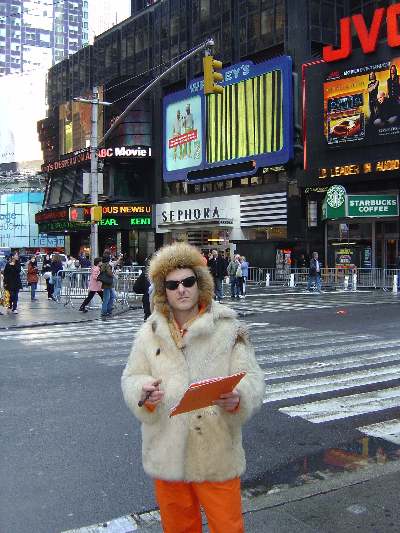 | Born in 1966 in (Israel) Lives and works in Paris (France ) | Biographie Bibliographie Liste expositions |
 | Born in 1966 in (Israel) Lives and works in Paris (France ) | Biographie Bibliographie Liste expositions |
After studying history at the University of Paris 1 Panthéon-Sorbonne, from which he graduated in 1988, Michael Blum attended the Ecole Nationale supérieure de la Photographie in Arles and obtained his diploma in 1992. He then spent two years at the Rijksakademie in Amsterdam.
Influenced by the work of the OuLiPo, he was initially interested in language. His first video, produced in 1992, Choses à récupérer chez Milena (à l'exception des meubles, de l'aspirateur et des rideaux, qui seront repris lors d'un déménagement ultérieur) is a methodical exploration of everyday objects classified in the form of lists. Le Réseau (1992/1997) is a series of interventions into public space in various cities in Europe, in which the artist uses language like a network of signs. For each action, he chooses a city space and stencils acronyms on the ground.
Since then, he has developed a body of work using various media, which proposes a critical and sarcastic rereading of culture, history and the global economy. Through apparently naïve projects, he deals with notions of displacement and globalisation – as in My Sneakers (2001), in which Michael Blum travels to Indonesia to find the site of manufacture of the pair of Nike he bought on sale in Paris, hence provoking geopolitical thought from a personal investigation. He also directed 17 Aandbloem street (2003) in Cape Town, involving a similar relationship confronting the individual with the world. In documentary form, he filmed stories between neighbours in an apartment block in South Africa. He gives a sociological and political dimension to some very local problems, in a country marked by Apartheid. With Lippmann, Rosenthal & Co, an installation presented in 2006 in Amsterdam, he shares his attentive gaze with the public, concerning the multiple readings of history. He thus reconstitutes the premises of a Dutch Jewish bank in its original building – now the De Appel Contemporary Art Centre – by gathering the company's archives and by calling in a medium to the site.
Michael Blum analyses global capitalism and its economic characteristics with irony. He uses displacement and subversion, not to create polemics, but to reveal the absurdity engendered by certain mechanisms of the modern economy. In Wandering Marxwards (1999), the artist politically and poetically questions the impact of Marx's theories within the history of modern North American capitalism. Michael Blum thus develops a politically committed artistic practice by way of various media and techniques. Also included among his works are photographs and photomontages such as Upside Town (White Skin, Black Mask) (2004), a homage to Franz Fanon, and videos such as Old boys and toys (2005), about retired men who collect toys. Some of his works also use the medium of Internet, such as Actions Virtuelles (1996), and the press, such as La Dernière Brève (2004) in which he repeatedly published a series of brief news items in a local paper – the “Républicain Lorrain” – as part of an artist's residency in the Moselle area in northeastern France. He also produced publications such as Homo Œconomicus (2000), reworking Marx's analyses, and potlach.doc (2001 and 2002). This booklet comprises a collection of historical and contemporary images from advertising, press photos, screen captures, illustrations, archive images and children's books. Moreover, it is also designed as a non-commercial exchange between the artist and his readers, since it was distributed free of charge in public establishments, airports, train stations, banks and insurance companies in several cities around the world.
Michael Blum also intervenes in urban space with works like Laborinto (2002), for which he installed a human-sized labyrinth using construction site railings, on the Piazza Vittorio in Turin. Also in 2002, the artist produced 400 jaar zonder graf, dan heb je lang gezwegen (400 years without a grave is a long time to shut up), the tombstone of Cornelius de Houtman, a Dutch navigator who discovered Indonesia and who has disappeared from the country's collective memory. By way of a sound system hidden within the stele, the navigator addresses visitors, deploring the fact that he has been forgotten, and bringing up various themes such as globalisation or the euro.
Michael Blum's reappropriation of the images and symbols of capitalism, and, broadly, of history, allow us to identify him as a political artist whose artistic practice leads the spectator to reflect on notions of past and future, from both an economic and a cultural perspective.
Priscilia Marques
Translated by Yves Tixier and Anna Knight